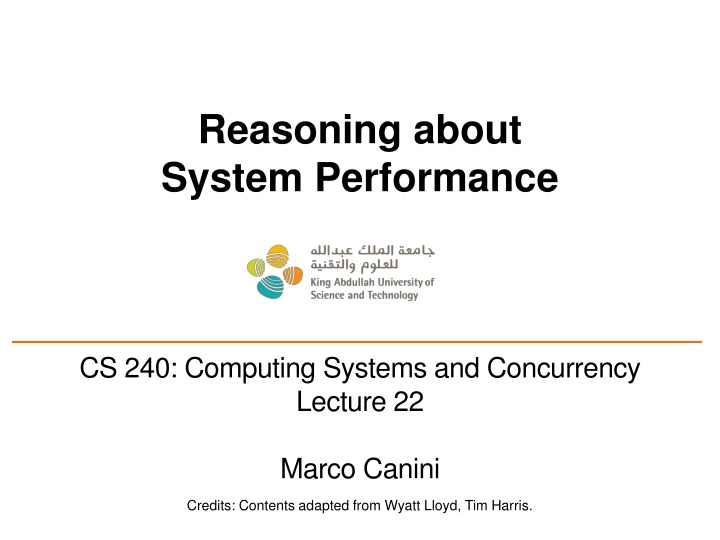Reasoning About System Performance
The study of system performance involves analyzing the entire system's components, both physical and software, to ensure correct and efficient operation. Key terms include workload, utilization, saturation, bottleneck, and response time. Various roles are interested in performance evaluation, requiring deep system knowledge and methodological expertise. Performance evaluation is considered an art that demands careful selection of tools, workloads, and methodologies.
Download Presentation

Please find below an Image/Link to download the presentation.
The content on the website is provided AS IS for your information and personal use only. It may not be sold, licensed, or shared on other websites without obtaining consent from the author.If you encounter any issues during the download, it is possible that the publisher has removed the file from their server.
You are allowed to download the files provided on this website for personal or commercial use, subject to the condition that they are used lawfully. All files are the property of their respective owners.
The content on the website is provided AS IS for your information and personal use only. It may not be sold, licensed, or shared on other websites without obtaining consent from the author.
E N D
Presentation Transcript
Reasoning about System Performance CS 240: Computing Systems and Concurrency Lecture 22 Marco Canini Credits: Contents adapted from Wyatt Lloyd, Tim Harris.
Context and todays outline We cared a lot about: Are the results correct? But in practice we also need to consider quantitatively: Are the results obtained in a reasonable time? Is a system faster than another one? Today How to analyze the performance of a system? 2
Whats systems performance? The study of an entire system, including all physical components and the full software stack Include anything that can affect performance Anything in the data path, software or hardware For distributed systems, this means multiple servers Perturbations Input System Under Test Resulting Performance (Workload) 3
Some terms Workload The input to the system or load applied Utilization A measure of how busy a resource is The capacity consumed (for a capacity-based resource) Saturation The degree to which a resource has queued work it cannot service Bottleneck A resource that limits the system performance 4
More terms Response time (also latency at times) The time for an operation to complete Includes any time spent waiting (queuing time) and time spent being serviced (service time), and time to transfer the result Input Response Time Queue Server Output 5
Who in interested? Many roles: Sys admins / capacity planners Support staff Application developers DB / Web admins Researchers Performance engineers (primary activity) 6
Performance evaluation is an art Like a work of art, a successful evaluation cannot be produced mechanically Every evaluation requires an intimate knowledge of the system and a careful selection of methodology, workloads and tools Performance is challenging 7
Performance is subjective Is there an issue to begin with? If so, when is it considered fixed? Consider: The average disk I/O response time is 1 ms Is this good or bad? Response time is one of the best metrics to quantify performance; the difficulty is interpreting its information Performance objectives and goals need to be clear Orient expectations as well as choice of techniques, tools, metrics and workloads 8
Systems are complex Many components and sources of root causes Issues may arise from complex interactions between subsystems that operate well in isolation Cascading failures: when one failed component causes performance issues in others Bottlenecks may be complex and related in unexpected ways Fixing one may simply move the bottleneck elsewhere Issue may be caused by characteristics of workload that are hard to reproduce in isolation Solving complex issues often require a holistic approach The whole system needs to be investigated 9
Example of cascading failure Workflow Workflow App 3 x10 App 1 Front end service service service Upstream service Database service service service Front end Front end Database Database App 2 August 2014 outage One request type was accessing a single slow database and exhausted an upstream service s thread pool This starved other unrelated requests causing application unavailability 10
Measurement is crucial You can t optimize what you don t know Must quantify the magnitude of issues Measuring an existing system helps to see its performance and perhaps the room for possible improvements Need to define metrics Know your tools! Be systematic! Don t reinvent the wheel! 11
Measuring Distributed Systems Client 1 Client 2 Distributed System Client N 12
Measuring Distributed Systems Distributed System Client 13
Latency The time spent waiting E.g., setup a network connection OR (broadly) The time for a request/operation to complete E.g., data transfer over the network, an RPC, a DB query, a file system write Measured externally from time request is sent until time response is received Can allow to estimate maximum speedup E.g., assume the network had infinite capacity and transfer were instantaneous, how fast would the system go? 14
Latency, Measure Externally Distributed System Client 15
Latency, Reason Internally Single Machine Client Server 16
Latency, Reason Internally Single Machine 1 2 Client Server 3 Latency = 1 + 2 + 3 17
Throughput The rate of work performed: how many operations per unit time (ops/s) a system can handle In communication: Data rate: bytes per second, bits per second (Goodput useful throughput: rate for the payload only) Systems: Operation rate: ops per second, txns, per second IOPS Input/output operations per second E.g., reads and writes to disk per second Measured externally as the rate that responses come out of the system 18
Max Throughput Example (Not Ideal) Single Machine Client Server Throughput = Number of (valid) responses received by all clients End time start time 19
Queuing Delay & Overload Single Machine Client Server Queuing delay: extra latency spent in queue(s) Higher load increase in latency Overload: offered load > max system throughput Queues get really long Other weird/bad things happen Observed throughput < max system throughput 20
Utilization, Saturation Utilization (time-based) = B/T B is amount of time the resource was busy during T Intuitively, how busy a component is Utilization Saturation 100% 0% Load 21
Performance degradation Response Time Actual Linear Load 22
Measuring Throughput Method 1. Starting with low load 2. Increase load 3. Repeat until measured throughput stops increasing 23
Throughput, Reason Internally Single Machine Client Server 24
Throughput, Reason Internally Single Machine 1 2 Client Server 3 Throughput = min(1, 2, 3) 25
Throughput Bottlenecks (simplified) Single Machine 1 2 Client Server 3 Max throughput limited by some bottleneck resource: 1) Incoming bandwidth 2) Server CPU 3) Outgoing bandwidth 26
Load Generation Closed-loop Each client sends one request, waits for the response to come back, and then sends another request More clients => more load Open-loop Load is generated independently of the response rate of the system, typically from a probability distribution More directly control the load on the system Which one is more realistic? We ll reason using closed-loop clients 27
Mental Experimental Setup Start with 1 closed-loop client Expected latency? Expected throughput? Double number of closed-loop clients Expected increase in latency? Expected increase in throughput? Repeat 28
Throughput-Latency Graph Simple Setting: Single Server; Client-Server RTT 90ms; Server Processing latency 10ms; Single-Threaded Server (100 ops/s) Latency (ms) 100 40 10 20 100 Throughput (operations/sec) 29
Throughput-Latency Graph Overload Latency Underloaded Common operating point: 70-80% max load Throughput 30
Throughput / Latency Relationship Proportional at low load but not high load Because measured throughput is a function of latency i.e., throughput bottleneck is offered load Related, but you should reason about both For system A vs system B, all are possible: A has lower latency and higher throughput than B A has lower latency and lower throughput than B A has higher latency and lower throughput than B A has higher latency and higher throughput than B 31
Scalability Linear Saturation Actual Throughput Knee point: beyond it, contention for resources increases; a component becomes 100% utilized Load 32
Evaluation in Minutes not Months Reasoning using your mental model is much much faster than really doing it What would happen if? I moved my servers from the San Jose datacenter to Oregon? I switch from c5.xlarges to c5.24xlarges for my servers? I doubled the number of servers? I switch from system design X to system design Y? replace single server with Paxos-replicated system? replace Paxos with eventually consistent design? add batching? replace Paxos with new variant? 33
Mental Experimental Setup System A versus System B From 1 to N closed-loop clients loading each Compare throughput and latency 35
Move Single Server from San Jose to Oregon (Clients in San Jose) Server in San Jose Server in Oregon Latency Throughput 36
Replace Single Server with Paxos (Clients and servers in same datacenter, 3 replicas) Single Server Paxos Latency Throughput 37
Paxos: 3 replicas to 5 replicas (Clients and servers in same datacenter) 3 replicas 5 replicas Latency Throughput 38
Paxos: 3 replicas to 30 replicas (Clients and servers in same datacenter) 3 replicas 30 replicas Latency Throughput 39
Batching Group together multiple operations Improves throughput, e.g., Marshall data together Send to network layer together Unmarshall data together Handle group of operations together Delay processing/sending operations to increase batch size Common way to trade an increase in latency for increase in throughput 40
Paxos with batching (Clients and servers in same datacenter, 3 replicas) no batching with batching Latency Throughput 41
Paxos: 3 local replicas to geo-replicated (Clients in NY; replicas in NY, Oregon, Singapore all local leader in NY leader in Singapore Latency Throughput 42
Summary Measure distributed systems externally Latency: how long operations take Throughput: how many operations/sec Reason about latency and throughput using internal knowledge of system design (and back-of-the-envelope calculations) Reason about effects on latency and throughput from changes to system choice, deployment, design Critical tool in system design 43
Five ways not to fool yourself or: designing experiments for understanding performance Tim Harris https://timharris.uk/misc/five-ways.pdf 44
Measure as you go Develop good test harness for running experiments early Have scripts for plotting results Automate as much as possible Ideally it is a single click process! Divide experimental data from plot data
Gain confidence (and understanding) Plot what you measure Be careful about trade-offs Beware of averages Check experiments are reproducible (Also statistics! Deal with outliers, repetitions)
Include lightweight sanity checks It s easy for things to go wrong and without noticing Make sure you catch problems Have sufficiently cheap checks to leave on in all runs Have sanity checks at the end of a run And don t output results if any problem occurs
Understand simple cases first Start with simple settings and check the system behaves as expected Be in control of sources of uncertainty to the largest extent possible And use checks to detect if that assumption does not hold Simplify workloads and make sure experiments are long enough Use these as a performance regression test for the future
Look beyond timing End to end improvements are great but are they happening because of your optimization? Try to link differences in workloads with performance Look further into differences in resource utilization and statistics from performance counters
Toward production setting Do observations made in simple controlled settings hold in more complex environments? If that is not true, try to decouple a number of aspects of this problem Change one factor at a time Try to understand the differences























